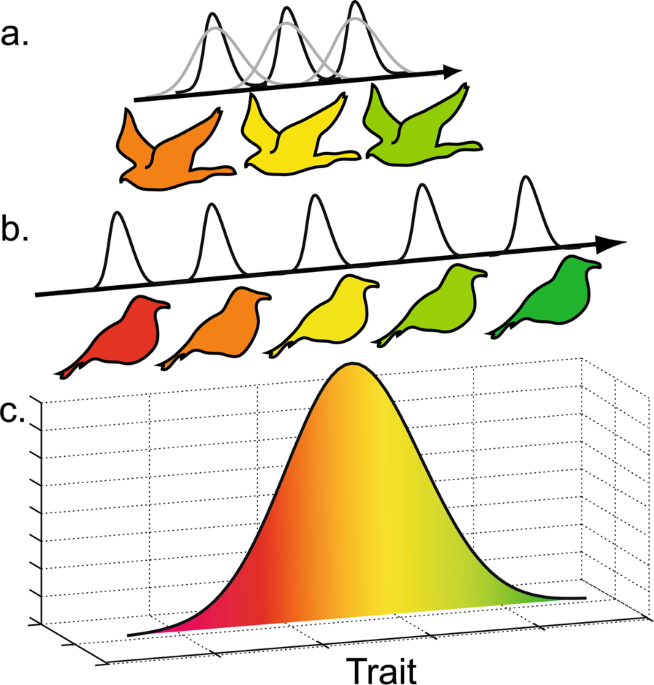
Ellner, S. P., Geber, M. A. & Hairston, N. G. Does rapid evolution matter? Measuring the rate of contemporary evolution and its impacts on ecological dynamics. Ecol Lett 14, 603–614 (2011).
Yoder, J. B. et al. Ecological opportunity and the origin of adaptive radiations. J Evolution Biol 23, 1581–1596 (2010).
Losos, J. B. Adaptive Radiation, Ecological Opportunity, and Evolutionary Determinism. Am Nat 175, 623–639 (2010).
Meyer, J. R. & Kassen, R. The effects of competition and predation on diversification in a model adaptive radiation. Nature 446, 432–435 (2007).
Brodersen, J., Post, D. M. & Seehausen, O. Upward Adaptive Radiation Cascades: Predator Diversification Induced by Prey Diversification. Trends Ecol Evol 33, 59–70 (2018).
Schluter, D. The ecology of adative radiations. (Oxford university press, 2000).
Grant, P. R. Evolution on islands. (Oxford University Press, 1998).
MacArthur, H. R. & Wilson, E. O. The theory of island biogeography. (Princeton university press, 1968).
Geritz, S. A. H., Kisdi, E., Meszena, G. & Metz, J. A. J. Evolutionarily singular strategies and the adaptive growth and branching of the evolutionary tree. Evol Ecol 12, 35–57 (1998).
Dieckmann, U. & Doebeli, M. On the origin of species by sympatric speciation. Nature 400, 354–357 (1999).
Brännström, Å., Johansson, J. & von Festenberg, N. The hitchhiker’s guide to adaptive dynamics. Games 4, 304–328 (2013).
Brown, J. S. & Vincent, T. L. Organization of Predator-Prey Communities as an Evolutionary Game. Evolution 46, 1269–1283 (1992).
Ripa, J., Storlind, L., Lundberg, P. & Brown, J. S. Niche co-evolution in consumer-resource communities. Evol Ecol Res 11, 305–323 (2009).
Ito, H., Shimada, M. & Ikegami, T. Coevolutionary dynamics of adaptive radiation for food-web development. Popul Ecol 51, 65–81 (2009).
Pontarp, M., Ripa, J. & Lundberg, P. On the origin of phylogenetic structure in competitive metacommunities. Evol Ecol Res 14, 269–284 (2012).
Pontarp, M., Ripa, J. & Lundberg, P. The biogeography of adaptive radiations and the geographic overlap of sister species. Am Nat 186, 565–581 (2015).
Pontarp, M. & Wiens, J. J. The origin of species richness patterns along environmental gradients: uniting explanations based on time, diversification rate and carrying capacity. J Biogeogr 44, 722–735 (2017).
Brännström, A., Loeuille, N., Loreau, M. & Dieckmann, U. Emergence and maintenance of biodiversity in an evolutionary food-web model. Theor Ecol-Neth 4, 467–478 (2011).
Sauterey, B., Ward, B., Rault, J., Bowler, C. & Claessen, D. The Implications of Eco-Evolutionary Processes for the Emergence of Marine Plankton Community Biogeography. Am Nat 190, 116–130 (2017).
Pontarp, M. & Petchey, O. L. Ecological opportunity and predator–prey interactions: linking eco-evolutionary processes and diversification in adaptive radiations. Proceedings of the Royal Society B: Biological Sciences 285, (2018).
Loeuille, N. & Loreau, M. Evolutionary emergence of size-structured food webs. P Natl Acad Sci USA 102, 5761–5766 (2005).
Doebeli, M. & Dieckmann, U. Speciation along environmental gradients. Nature 421, 259–264 (2003).
Heinz, S. K., Mazzucco, R. & Dieckmann, U. Speciation and the evolution of dispersal along environmental gradients. Evol Ecol 23, 53–70 (2009).
Brose, U., Williams, R. J. & Martinez, N. D. Allometric scaling enhances stability in complex food webs. Ecol Lett 9, 1228–1236 (2006).
Leyequien, E., de Boer, W. F. & Cleef, A. Influence of body size on coexistence of bird species. Ecol. Res. 22, 735–741 (2007).
Yvon-Durocher, G. et al. Across ecosystem comparisons of size structure: methods, approaches and prospects. Oikos 120, 550–563 (2011).
Rudolf, V. H. W. Seasonal shifts in predator body size diversity and trophic interactions in size-structured predator-prey systems. J Anim Ecol 81, 524–532 (2012).
DeLong, J. P. & Vasseur, D. A. A dynamic explanation of size-density scaling in carnivores. Ecology 93, 470–476 (2012).
DeLong, J. P. & Vasseur, D. A. Size-density scaling in protists and the links between consumer-resource interaction parameters. J Anim Ecol 81, 1193–1201 (2012).
Violle, C. et al. Let the concept of trait be functional! Oikos 116, 882–892 (2007).
Christiansen, F. B. & Loeschcke, V. Evolution and intraspecific exploitative competition I. One-locus theory for small additive gene effects. Theor Popul Biol 18, 297–313 (1980).
Brown, J. S. & Vincent, T. L. A Theory for the Evolutionary Game. Theor Popul Biol 31, 140–166 (1987).
Pontarp, M. & Petchey, O. L. Community trait overdispersion due to trophic interactions: concerns for assembly process inference. P Roy Soc B-Biol Sci 283, (2016).
Pontarp, M., Brännström, A. & Petchey, O. L. Inferring community assembly processes from macroscopic patterns using dynamic eco-evolutionary models and Approximate Bayesian Computation (ABC). Methods Ecol Evol 10, 450–460 (2019).
Muir, A. M., Hansen, M. J., Bronte, C. R. & Krueger, C. C. If Arctic charr Salvelinus alpinus is “the most diverse vertebrate’, what is the lake charr Salvelinus namaycush? Fish Fish 17, 1194–1207 (2016).
Brodersen, J., Howeth, J. G. & Post, D. M. Emergence of a novel prey life history promotes contemporary sympatric diversification in a top predator. Nat Commun 6, (2015).
Petchey, O. L. & Gaston, K. J. Functional diversity: back to basics and looking forward. Ecol Lett 9, 741–758 (2006).
Pennekamp, F. et al. Biodiversity increases and decreases ecosystem stability. Nature 563, 109–112 (2018).
Sjödin, H., Ripa, J. & Lundberg, P. Principles of niche expansion. P Roy Soc B-Biol Sci 285, (2018).
Ackermann, M. & Doebeli, M. Evolution of niche width and adaptive diversification. Evolution 58, 2599–2612 (2004).
Case, T. J. An illustrated guide to theoretical ecology. (Oxford University Press, Inc., 2000).
Ito, H. C. & Dieckmann, U. A new mechanism for recurrent adaptive Radiations. Am Nat 170, E96–E111 (2007).
Metz, J. A. J., Nisbet, R. M. & Geritz, S. A. H. How should we define fitness for general ecolgical scenarios. Trends Ecol Evol 7, 198–202 (1992).
Source: Ecology - nature.com


